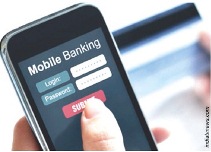Apr.19: SPOTLIGHT
- Posted by CERC India
- Posted in April
Know the risks of mobile banking Â
Oh! The convenience of conducting banking transactions anywhere, anytime on your mobile phone! But what you don’t realise is that as more and more people start using mobile banking services, the security risk increases. You should be aware of the risks described below.
Mobile malware: Malware specifically targeting mobile devices has become a very real and prominent threat. These include viruses and spyware.
Fake apps: These have exactly the same user interface as the original application and are created to steal confidential information shared by the user. That’s why it’s better to download apps from the appropriate websites and not with the help of a search engine.
Third-party apps: Fraudsters could use your banking login information or credit card details stored in a shopping app to facilitate a transaction. It is not advisable to store a particular card or bank as your preferred choice of payment in shopping apps.
Wrong mapping of app: If there’s a bank customer who is not interested in mobile banking, an insider (employee) of the bank could attach a mobile number to the bank account and install an app  on the mobile device.
SIM swap fraud: If a fraudster manages to do such a swap without your knowledge, he can carry out transactions using your mobile number.
Unsecure wifi networks: If you plan to use a mobile app to conduct a sensitive transaction, use a secure wireless network or your phone’s data network. Wifi hotspots are often spoofed by fraudsters.
Poor reception: This indicates poor security. There is risk that the data contained in your banking transaction could misfire and be intercepted by an unauthorized third party.
Lost or stolen devices: Studies show that nearly 40% of smartphone owners do not password protect their devices. If they lose their phone, anyone could pick it up, log into their banking app and access their money.
SMShing: Mobile device users may trust SMS text messages more than email and therefore may be more likely to click on links to malicious websites.
Finally, on their part, financial institutions must adopt mobile malware detection and technology solutions and educate their customers about security issues.
Sources: Financial Express, securityintelligence.com, www.bankinfosecurity.com




